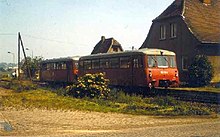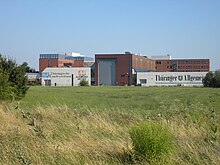Bindersleben
|
Bindersleben
State capital Erfurt
Coordinates: 50 ° 58 ′ 27 ″ N , 10 ° 57 ′ 4 ″ E
|
|
|---|---|
| Height : | 300 (300-312) m |
| Area : | 8.06 km² |
| Residents : | 1465 (December 31, 2016) |
| Population density : | 182 inhabitants / km² |
| Incorporation : | July 1, 1950 |
| Postal code : | 99092 |
| Area code : | 0361 |
|
Location of Bindersleben in Erfurt
|
|

Bindersleben is a district of Erfurt in Thuringia . The village with around 1300 inhabitants is located west of the city center at Erfurt-Weimar Airport .
geography
Bindersleben is about six kilometers west of Erfurt city center on the Alacher Höhe , a plateau belonging to the Thuringian Basin . The source brooks of the Nesse , which belongs to the catchment area of the Weser , run to the west of the town , while the Espach rises south of the town, which flows into the Gera in Erfurt and is thus in the catchment area of the Elbe . A large part of the northern district area is taken up by the airport, while to the west of Bindersleben im Ried there are some small wooded areas and the rest of the district area is used for agriculture.
Bindersleben is around 300 meters above sea level and thus around 100 meters above the center of Erfurt. Neighboring districts are Alach in the northwest, Salomonsborn in the north, Marbach in the northeast, Brühlervorstadt in the east, Schmira in the south, Frienstedt in the southwest and Gottstedt in the west.
Climate and weather station
In Bindersleben there is a meteorological station manned around the clock , which is supposed to be representative of the natural area of the southern Thuringian basin. It is one of the 16 German aviation weather stations of the German Meteorological Service (10554 Erfurt-Weimar) and is located at an altitude of 316 m above sea level. However, the urban area of Erfurt lies 120 meters lower in a valley basin, so that there are on average higher temperatures and lower rainfall. The Thuringian Basin is also a little warmer and lower in precipitation than the area around Bindersleben.
Characteristic for the weather in the region are frequent dry periods lasting weeks and always light, but never particularly strong, westerly winds. Since 2000 the extreme values measured at the Bindersleben station were:
- highest maximum temperature: +34.9 ° C on August 12 , 2003 , +34.5 ° C on July 20, 2006
- Lowest maximum temperature: -14.0 ° C on December 19, 2009, -13.1 ° C on January 8, 2003
- lowest minimum temperature: -26.5 ° C on January 7, 2003, -22.8 ° C on December 20, 2009
- Strongest wind gusts: 118.8 km / h on January 18, 2007 ( Hurricane Kyrill ), 114.5 km / h on October 27, 2002 ( Hurricane Jeanett ), 114.1 km / h on December 16, 2005 ( Hurricane Dorian )
- strongest precipitation in one day: 75 mm on August 10, 2007, 63.2 mm on July 7, 2006
- heaviest precipitation on consecutive days (at least 10 mm per day): 103.8 mm on the 8th – 10th August 2007, 85.0 mm on 27./28. September 2007
- Warmest months (average of daily maximum temperatures): July 2006: 28.2 ° C, August 2003: 27.3 ° C
- Coldest months (average of daily maximum temperatures): January 2010: –3.0 ° C, January 2006: –1.3 ° C
- Months with the most hours of sunshine: July 2006: 344.1 hours, June 2003: 314.3 hours
- Months with the fewest hours of sunshine: December 2008: 24.5 hours, December 2001: 24.7 hours
- Rainiest months: August 2007: 135.4 mm, May 2004: 134.0 mm
- Rainiest months: October 2007: 6.8 mm, January 2009: 6.9 mm
history
Bindersleben was first mentioned in a document in 1104. The feudal lordship over the place was incumbent on the Archbishops of Mainz , who originally maintained a Vorwerk in Bindersleben . In 1158 the archbishop's lands were wholly or partly transferred to the Peterskloster . The monastery already owned land in Bindersleben in 1104, and it has acquired more over the years. In 1351 the council of Erfurt bought half of the court from Bindersleben, the other half was probably acquired in the 16th century. The Protestant village church is consecrated to St. Luke . Since the administrative reform of the Erfurt state in 1706, Bindersleben belonged to the Alach office. In 1802 he came with the Erfurt area to Prussia and between 1807 and 1813 to the French principality of Erfurt . With the Congress of Vienna the place came back to Prussia in 1815 and in 1816 it was affiliated to the Erfurt district in the Prussian province of Saxony .
Between 1924 and 1994 Bindersleben had a railway connection on the Erfurt – Nottleben railway line , although passenger traffic on this line had been suspended since 1967. In the interwar period, the urban development of Erfurt expanded further west along the Binderslebener Landstrasse. In addition, the airport was opened as a military airfield in 1935. Both gave the place an initial impetus for development and ensured an increasing number of residents.
The village was also hit in an air raid on Erfurt and Bindersleben airfield on July 20, 1944 by the US Air Force . 16 high-explosive bombs completely destroyed 11 residential buildings and damaged another 24 severe to moderate damage. The St. Lucas Church suffered considerable damage and could no longer be used. Accompanying fighters of the heavy bombers flew attacks with on-board weapons on the village. 21 people died among the inhabitants.
On April 10, 1945, twelve German soldiers died in or near Bindersleben and were buried in the local cemetery. On the same day the place was occupied by US troops , who were relieved by the Red Army in early July 1945 .
Bindersleben was incorporated into the city of Erfurt on July 1, 1950. Since 1956 the airport has also been used for civilian purposes. After reunification, an ambitious expansion program followed, which further enhanced the importance of the airport. In addition, Bindersleben became one of the main areas of expansion for urban development in Erfurt in the 1990s, especially with regard to office space. The Airfurt office park was built at the airport east of the town and the Thuringia newspaper group set up its headquarters to the west of the town . Residential development also expanded significantly after 1990. The largest new building area with single and multi-family houses was built on Orionstrasse, southeast of the actual town. In 2005 the Erfurt Stadtbahn was extended from the main cemetery via the airport to Bindersleben, so that there is a regular train connection to Erfurt city center. In the course of suburbanization after 1990, the population of Bindersleben more than doubled.
Population development
- 1843: 465
- 1910: 641
- 1939: 822
- 1990: 568
- 1995: 632
- 2000: 1180
- 2005: 1326
- 2010: 1333
- 2015: 1416
politics
The district mayor has been Cornelia Nitzpon, a former PDS member of the state parliament, since 2009 . She won the local elections in 2009 against Horst Braun, who has been in office since 1994.
Economy and Infrastructure

The Erfurt-Weimar airport is located in Bindersleben. Its runway is parallel to the village road to the north. At the airport at the eastern end of the town, a large commercial area was built in the 1990s, which primarily offers office space and is marketed under the name Büropark Airfurt . Since 2005 there has been a tram connection to the center of Erfurt in Bindersleben. There are connections to neighboring towns to the west via bus lines.
Federal road 7 runs south of the village . The motorway exit 11 of the A 71 Erfurt-Bindersleben is about two kilometers southwest of the village. In 2005 the only IKEA furniture store in Thuringia set up shop here. Roads connect the place with Erfurt in the east, the B 7 in the south, Gottstedt in the west and Alach in the north.
Monuments and tombs
- A memorial with name plaques for the fallen of the First World War in the cemetery was - financed by donations - supplemented in 2011 by the 45 dead of the Second World War and inaugurated. In front of the memorial there are grave crosses for six fallen soldiers from the First World War and a soldier buried here in 1943.
- On another field of the cemetery there are stone grave crosses for twelve German soldiers who died on April 10, 1945 and 18 victims of the bomb attack on the village on July 20, 1944 (including 8 children and 9 women). A simple wooden cross reminds of two people from Bindersleben who died in the Soviet Buchenwald internment camp in 1948 .
Personalities
- Johann Heinrich Buttstedt (1666–1727), organist and composer, born in Bindersleben
- Jakob Adlung (1699–1762), organist, composer and instrument maker, born in Bindersleben
- Johann Christoph Bach (1782–1846), organist
Individual evidence
- ↑ Data from the DWD
- ^ History of Bindersleben on the Erfurt homepage
- ↑ Helmut Wolf: Erfurt in the air war 1939-1945 . Glaux-Verlag Jena, 2005. ISBN 3-931743-89-6 . P. 137
- ↑ Municipalities 1994 and their changes since January 1, 1948 in the new federal states , Metzler-Poeschel publishing house, Stuttgart, 1995, ISBN 3-8246-0321-7 , publisher: Federal Statistical Office
- ^ Handbook of the Province of Saxony, Magdeburg 1843.
- ↑ gemeindeververzeichnis.de
- ↑ Michael Rademacher: German administrative history from the unification of the empire in 1871 to the reunification in 1990. (Online material for the dissertation, Osnabrück 2006).
- ^ Thuringian State Office for Environment and Geology: Environment regional.
- ↑ Population of the city districts
- ↑ Anja Derowski: Commemoration of the bombing. In Bindersleben, residents remember one of the worst days in the history of the place . Thuringian national newspaper, July 20, 2015
literature
- Max Paul Bertram: Bilterisleybin. History of the village Bindersleben in Erfurt, processed on the basis of scientific sources, with illustrations and own photographic images , Bindersleben 1904 ( reprint the publishing house skirt chair , bath Langensalza, 2010. ISBN 3-936030-20-0 ).
- Barbara Gottmannshausen, Roland Bräutigam: Chronicle of the Bindersleben community 1904–2004, created on the occasion of the 900th anniversary , Bindersleben 2004.



